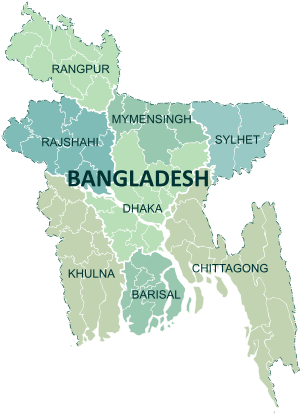Noakhali District
Noakhali (Bengali: নোয়াখালী জেলা)[2] is a district in South-eastern Bangladesh. It is located in the Chittagong Division.[3] Noakhali district, whose earlier name was Bhulua, was established in 1821. It was named Noakhali in 1868.
Noakhali District নোয়াখালী, ভুলুয়া । | |
|---|---|
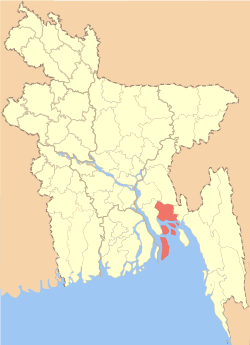 Location of Noakhali District in Bangladesh | |
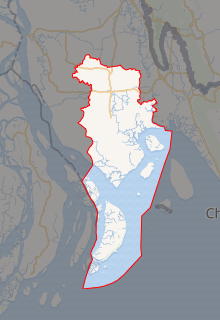
Expandable map of Noakhali District | |
| Coordinates: 22.70°N 91.10°E | |
| Country | |
| Division | Chittagong Division |
| Established | 1821 |
| Area | |
| • District | 4,202.70 km2 (1,622.67 sq mi) |
| • Metro | 369.59 km2 (142.70 sq mi) |
| Population (2011census) | |
| • District | 3,109,078 |
| • Density | 740/km2 (1,900/sq mi) |
| Literacy rate | |
| • Total | 70.65% |
| Time zone | UTC+06:00 (BST) |
| Postal code | 3800 |
| HDI (2018) | 0.596[1] medium · 11th of 21 |
| Website | www.noakhali.gov.bd |
Geography
Noakhali District is bordered by the Comilla district to the north, the Meghna estuary and the Bay of Bengal to the south, Feni and Chittagong districts to the east and Lakshmipur and Bhola districts to the west. The district has an area of 4,202 km2 (1,622 sq mi).[4] The district represents an extensive flat, coastal and delta land, located on the tidal floodplain of the Meghna River delta, characterised by flat land and low relief. The area is influenced by diurnal tidal cycles; the tidal fluctuations vary depending on seasons, and are most pronounced during the monsoon season. On three sides of Noakhali an alluvial plain that is inundated annually and fertilised by silt deposits from the Meghna estuary. The swift currents that course down from the Himalayas carry rich fertile silt. When it reaches the Bay of Bengal the silt settles along the coast gradually forming new land called the "chars". The district of Noakhali has actually gained more than 73 km2 (28 sq mi) of land in the past fifty years.[5]
Climate
Noakhali has a tropical climate and has significant rainfall in most months of the year, with a short dry season. In Noakhali, the average annual temperature is 25.6 °C (78.1 °F) and the average annual rain fall is about 3,302 mm (130.0 in). With an average temperature of 45.6 °C (114.1 °F), May is the warmest month. At 19.5 °C (67.1 °F) on average, January is the coldest month of the year. The driest month is January with 8 mm (0.31 in) of precipitation. In July, the rainfall reaches its peak, with an average of 671 mm (26.4 in).
Rivers and canals
- Meghna
- Bamni
- Noakhali Khal
- Mohendro Khal
- Dakatia Khal
- Chandraganj Khal
- Noa khal
History
.jpg)
Noakhali's ancient name was Bhulua. It was part of Pundra Kingdom.
In the 1660s, the agricultural activities of the north-eastern region of Bhulua were seriously affected by floodwaters of the Dakatia River flowing from the Tripura hills. To salvage the situation, a canal was dug in 1660 that ran from the Dakatia through Ramganj, Sonaimuri and Chaumuhani to divert water flow to the junction of the Meghna River and Feni. After excavating this long canal, Bhulua began to be known as "Noakhali". The name "Noakhali" originated from the terms "Noa" (New) and "Khal" (Canal).
Two hundred years ago Noakhali district was known as Bhulua Pargana. South Shahbazpur(Bhola), Lakshmipur, the mainland of Noakhali district and a portion of the present Feni district were included in the Bhulua Pargana. In 1821 Mr. Plyden, a salt agent, was the additional position of collectorate (district judge) of Bhulua by the governor general. He proposed to the governor general to establish a new district when some administrative problems arose with other Bhulua salt-agents. On 29 March 1822 the Governor General passed an order in this regard and accordingly a new district was constituted with: South Shabajpur, Sudharam, Begumganj, Ramganj, Raipur, Lakshmipur, Feni, Parshuram, Elahabad Pargana of Tippera and Hatia, Sandwhip and Bamni of Chittagong district. The district was named Noakhali in 1868. In 1876 Noakhali district was divided into two sub-divisions. Feni Sub-division was constituted with: Chhagalnaiya thana of Tippera, Mirshari of Chittagong, Feni Pargana, Parshuram and Sonagazi. Sadar Sub-division was formed with the remaining areas. In the 1901 census its area was 1,644 sq mi (4,260 km2) and its population was about 1,141,728.[6] Regional violence in 1946 escalated communal tensions throughout British India just before the 1947 partition. One of the worst religious massacres and incidents of ethnic cleansing against the Hindu community took place in Noakhali during the 1946 riot known as the Noakhali genocide. A huge number of mass killing, raping, looting, and forcible conversions took place. The prime minister of Bengal, Huseyn Shaheed Suhrawardy, answering a question from Dhirendranath Datta in the assembly early in 1947 stated that there had been 9,895 cases of forcible conversion in Tipperah alone. He said the number in Noakhali "ran into thousands".[7] It was not a random incident and was quite well planned, organised and directed by a few local political leaders.
Noakhali town, the headquarters of Noakhali, vanished in the river-bed in 1951 as a result of erosion of the Meghna River. After that the headquarters of Noakhali was established at Maijdee. In 1964, Sadar Sub-division was divided into two sub-divisions namely Sadar and Lakshmipur.
_%E0%A6%AA%E0%A6%B0%E0%A6%BF%E0%A6%95%E0%A6%B2%E0%A7%8D%E0%A6%AA%E0%A6%A8%E0%A6%BE.png)
During the Indo-Pakistani War of 1971 for the liberation of Bangladesh, when Pakistan Army created the 39th ad hoc Division in mid-November, from the 14th Division units deployed in those areas, to hold on to the Comilla and Noakhali districts, and the 14th Division was tasked to defend the Sylhet and Brahmanbaria areas only.[8] During the War of Liberation many direct and guerilla encounters took place between the Pakistani Armed Forces and the Liberation Forces (Mukti Bahini). During the 1971 Bangladesh genocide by the Pakistan, in which Pakistani Army and its supporting militias (Razakar) killed estimated between 300,000[9] to 3,000,000 people and raped 200,000–400,000 Bangladeshi women in a systematic campaign of genocidal rape,[10][11][12] about 75 Bengladeshi Freedom fighters (Mukti Joddha) were killed at Noakkhali in a direct encounter with the Pakistan army on 15 June 1971, in front of the Sonapur Ahmadia School. Noakhali was liberated on 7 December 1971. Pakistan Army's 93,000 troops unconditionally surrendered to the Indian Army and India's local ally Mukti Bahini on 16 December 1971.[13] This day and event is commemorated as the Bijoy Dibos (Bengali: বিজয় দিবস) in Bangladesh and Vijay Diwas in India.[14][15]
For administrative convenience, according to a Government, decision Noakhali district was divided into three districts, namely Noakhali, Lakshmipur and Feni in 1984.
Administration
District administration is headed by an accomplished professional called the Deputy Commissioner/District Magistrate.
The basic unit of administration of the country is locally named Upazila, which is an integral component of the district. Field level functionaries of the development departments operate here at the grass-root level under guidance from the respective functional heads stationed in the districts as coordinated by the Upazila Nirbahi Officer (UNO). All decisions are discussed and finalised in a forum called the Upazila Parishad which is presided over by an elected chairman and assisted by the UNO.
An area covering several square kilometres having a population of several thousand populations is called a Union, administered by an elected chairman. These chairmen are the dominant and voting members of the Parishad (counseling body) apart from various Upazila-level functionaries representing respective district counterparts.
Deputy Commissioner (DC): Tanmaya Das [16]
Administrator of Zila Parishad: ABM Zaforullah[17]
Administrative subdivisions
Noakhali District consists of: nine upazilas, eight municipalities, 72 wards, 153 mahallas, 91 unions, 882 mouzas and 967 villages.
Upazilas
Noakhali District is divided into the following Sub-districts (Upazilas):
Municipalities
A municipality is usually an urban administrative division having corporate status and usually powers of self-government or jurisdiction. Noakhali district has eight municipalities (Paurashavas). Every municipality consists of nine wards.
- Senbagh Municipality
- Noakhali Municipality (Maijdee)
- Chowmuhani Municipality
- Chatkhil Municipality
- Boshurhat Municipality
- Hatiya Municipality
- Kabirhat Municipality
- Sonaimuri Municipality
Unions
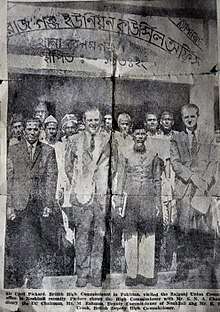
| Upazila | Union | Upazila | Union | Upazila | Union |
|---|---|---|---|---|---|
| Noakhali Sadar |
|
Begumganj |
|
Chatkhil |
|
| Companiganj |
|
Senbagh |
|
Hatiya |
|
| Sonaimuri |
|
Kabirhat |
|
Subarnochar |
|
National Parliament constituencies
There are six National Parliament (Bengali: জাতীয় সংসদ) constituencies in Noakhali district. These constituencies and the current members of parliament are:[18]
| Constituency | Name | Extent | MP | Party |
|---|---|---|---|---|
| 268 | Noakhali-1 | Chatkhil-Sonaimuri | H. M. Ibrahim | Bangladesh Awami League |
| 269 | Noakhali-2 | Senbag-Sonaimuri (partial) | Morshed Alam | Bangladesh Awami League |
| 270 | Noakhali-3 | Begumganj | Mamunur Rashid Kiron | Bangladesh Awami League |
| 271 | Noakhali-4 | Noakhali Sadar-Subarnachar | Mohammed Ekramul Karim Chowdhury | Bangladesh Awami League |
| 272 | Noakhali-5 | Companiganj-Kabirhat | Obaidul Quader | Bangladesh Awami League |
| 273 | Noakhali-6 | Hatiya | Ayesha Ferdaus | Bangladesh Awami League |
Demographics
According to the 2011 census the total population of Noakhali district is 3,318,083 (Male- 1,685,169 and Female- 1,622,914). The male to female ratio is 92:100; Population Density is 897/km2 (557/mi2); annual growth rate is 1.86%. The urbanisation rate of the district is 18.98%.[19] The main town Maijdee has a population of 84,585 (male 51.50%, female 48.50%) with a population density of 5,915/km2 (3,675/mi2).
Religion
People from many religions and faiths live in Noakhali. Around 95.42% of the local population are Muslims, while 4.52% are Hindus. Christians and Buddhists constitute 0.02% and 0.03% respectively. The district of Noakhali has 4,159 mosques, 497 Eid Gah, 239 temples, two Buddhist pagodas and two churches.[20]
Language
The people of this district speak Noakhailla which is a Bengali-Assamese language of Bangladesh. It is not only spoken by the people of Noakhal but also the people of Feni and Lakshmipur as well as southern parts of the district of Comilla, Mirsharai Upazila, Sandwip of Chittagongdistrict, Haziganj Upazila of Chadpur district. Indian nationals of Tripura state also speak the dialect of Noakhali. It is used as the lingua franca among the Indians of South Tripura District and it is also widely spoken in Gomati District and Sepahijala District of Tripura. The Noakhailla dialect is also understood and spoken by indigenous Tripuri Tribes and also Chakma, Mog (Marma), Reang etc. It is widely spoken in: Belonia, Manurmukh, Sabroom, Santirbazar, Joalibari, Baikhora, Kathalia, Barpathari, Trishna, Chandrapur, Garjee, Hrishyamukh, Satchand, Karbook, Natunbazar, Birchandra Manu, Rajnagar etc. Belonia is the Headquarters of South Tripura District which consists of three subdivisions namely Belonia, Santirbazar and Sabroom.
The Noakhailla dialect does not have any recognised grammar recording. There is no formal use of the Noakhailla dialect in public, in courts, or in the legislature like the existent standard Bangla. It remains as the language of the people of the Greater Noakhali region of Bangladesh. The educated, elite, political and influential groups of Bangladesh bearing Noakhali homogeneity, or being intrinsically exposed to the socio-cultural phenomenon of Noakhali, usually prefer the standard form of Bangla for their wider communication. They keep this dialect as their private means of communication only with members of the indigenous community of Greater Noakhali. This dialect is very famous in Bangladesh. A lot of Bangladeshi dramas are written in this dialect, so Bangladeshi actors actress are busy learning it.
Education
The literacy rate of Noakhali district is 69.57% (male- 72.40% and female- 67.60%). School attendance rate is 74.40% for the five to 24 years age group.[20]
In Noakhali there are 1,243 Primary Schools (Government: 776, Non-government: 329, Community: 76, Satellite: 62), 289 High Schools, 161 Madrashas (Senior Madrasha: 30, Dakhil and Alim Madrasha: 131), five Technical Institutions (Youth Training Center: two, PTI: one Technical School and College: two, 35 Colleges (Government: eight, Private: 27), one Medical Assistant Training School (MATS), one Agricultural Training Institute, one Government Medical College, one Homeopathic Medical College, one Textile Engineering College and one Science and Technology University.
History of Education System
The quality of the education system in this district is commendable. But it is necessary to look back at what the education system was like before. At the beginning of the Mughal and British rule, the education system was generally dependent on ‘tol’ schools and maktabs. These taught Arabic, Persian and Sanskrit. However, the education system gradually improved and the Minor School was established. There was only one English high school in the year of 1857. There were 69 students. In the next four years, the number of students stood at 71. But in the year 1871, the students' number reach number at 596, as well as the number of government and aided schools reached 26. In the survey of 1872, there were 74.66% of the Muslim population but their literacy rate was only 20% of the total population at that time. However, the literacy rate of Muslims increased very significantly in the next decade. The total number of schools was 2775 in the year 1895. At that time, some changes in education policy closed many schools, so the number of schools dropped to 1330 in the year of 1898. The number of students in this district was more than 12,000 in the year. Let's talk about high schools. In Noakhali, there were only five English high schools in 1905. Among them were Noakhali Zilla School, which was established in 1850 and was included as a Zilla School in 1853, Feni High School ( now Feni Government Pilot High School) which was established in 1886, Lakshmipur High School(now Lakshmipur Adarsha Samad Government High School) which was established in 1889, Sandwip Kargil High School now Kargil Government High School (1902). Since then, educational institutes have increased a lot until 1950. In the year of 1914, there were 5 more high schools were established in this district. They are Arun Chandra High School which was founded by the Bhulua Zamindar called Arun Chandra Singh Bahadur, Rajganj Union High School which was founded by Syed Sultan Alam Chowdhury and Rajgonj Banik family, Noakhali Ahmadiya High School, Begumganj High School and Khilpara High School which was situated at Ramganj Police Station. Noakhali Government Girls' High School was established in 1934 by Uma Devi. The number of high schools reached around 60 in the middle of the twentieth century. However, there was no other college besides Feni Government College, which was founded in 1922. So Chowmuhani College was established in 1943, laying the foundation by Dr. Magnad Saha. This college is now known as Chowmuhani Government S.A College. SA College was named after the heroic freedom fighter, Saleh Ahmed. On the other hand, Noakhali Government College was established in 1963, Noakhali Government Women's College in 1970, Noakhali Science and Technology University in 2005 and Abdul Malek Ukil Medical College, Noakhali was established in 2008. From then till today the education system of this district has reached the threshold of improvement.[21] [22]
Prominent educational institutions of Noakhali

University
College
- Abdul Malek Ukil Medical College, Noakhali, Chowmuhani
- Begumgonj Textile Engineering College, Noakhali, Chowmuhani
- Chowmuhani Govt. S. A College, Chowmuhani
- Noakhali Government College, Maijdee
- Noakhali Govt. Women's College, Maijdee
- Government Mujib College [23], Companigonj
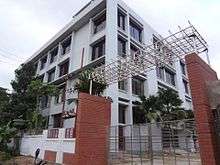
School
- Arun Chandra High School, Maijdee
- Basurhat A. H. C. Government High School, Companigonj
- Begumganj Govt. Pilot High School, Chowmuhani
- Chatkhil Govt. Girls' High School, Chatkhil
- Chatkhil P.G. Govt. High School, Chatkhil
- Chilonia Union High School, Senbagh
- Noakhali Medical Assistant Training School, Maijdee
- Noakhali Govt. Girls' High School, Maijdee
- Noakhali Zilla School, Maijdee
- Sonaimuri Model High School, Sonaimuri
Health
Noakhali district has one medical college, one general hospital (250 beds), eight Upazila health complexes (total 331 beds), 25 union sub-centers, 59 Union health and family welfare centers, one TB clinic, two school health clinics, one NGO clinic and three mother and children welfare clinics (Total 30 beds). There are 60 private hospitals and 115 diagnostic centers. 247 community clinics are now functioning. The activities of the Medical College Hospital is now in General Hospital.[24]
Coverage of households having access to safe drinking water is 90%, and coverage of households having access to sanitary latrines is 75% .
Economy
The people of Noakhali plays a vital role in Bangladesh's economy specially in the remittance sector. Agriculture plays a vital role in the regional economy. 30% of the regional GDP comes from agriculture with 45% of the population employed in the sector . Employment in the fishing industry is also dominant in the poorer sectors of the population. Annually, 15%–20% of labour is involved in this sector (boating, fishing, drying, net and boat making and repairing, transporting fish from one location to other). Poorer communities are involved in crop production during the winter but in other periods they are involved in fishing, either working for themselves or selling their labour to the mohajan. Around 40% of the population works abroad playing a vital role in the national economy. The main sources of income dependent on non-agricultural labour 3.43%, industry 0.84%, commerce 14.74%, transport and communication 3.83%, service 16.11%, construction 1.49%, religious service 0.39%, rent and remittance 7.97% and others 10.58%.
Agriculture
The economy of Noakhali is predominately agriculture. Of the total 544,943[20] holdings of the district 65.37% of the holdings are farms that produce varieties of crops, namely: local and hybrid rice, wheat, vegetables, spices, cash crops, pulses, betel leaves, boro and aman paddy, peanut, varieties of pulses, chili, sugarcane, potato, and others. Various fruits like mango, banana, jack fruit, papaya, litchi, palm coconut and betel nut are grown.
Fish of different varieties are found here in the sea and rivers and paddy fields in the rainy season. Fishes like ruhi, katla, mrigel, kala baush, koi, grass carp, silver carp, talapia, nilotica and different species of local deshi fishes have also been introduced for commercial pisciculture (fish farming) in ponds and waterlands.
Timber and forest trees are grown in this district including: koroi, sheel koroi, garjan, jarul, shimul, mahagonny, bamboo etc.
Transport
Noakhali district is connected by road, railway and waterway.
Airport
The Bangladesh government has declared the constitution of an airport in Noakhali Sadar Upazila which is Maijdee
Road
Noakhali is well connected with the Bangladeshi capital city of Dhaka and the port city of Chittagong. By road the distance between Dhaka and Noakhali is 151 km (94 mi). The distances from Chittagong and Comilla are 134 km (83 mi) and 95 km (59 mi) respectively. Buses are the most common form of transport and run to a wide range of destinations within and outside the district. A number of independent transport companies operate buses, trucks and other vehicles from different parts of Noakhali to Feni, Chandpur, Comilla, Dhaka and Chittagong. Trucks carry the majority of goods transported in the district.
Rail
Inter-City train the "Upakul Express" and Mail train "Noakhali Express" operate between Noakhali station and Kamalapur Railway Station in Dhaka. The local train that operates between Noakhali station and Laksam Railway Junction of Comilla stops at seven railway stations in Noakhali District—Noakhali (Sonapur), Harinarayanpur, Maijdee Court, Maijdee, Chowmuhani, Bazra and Sonaimuri.
Water transport
The Southern part of the Noakhali District and Hatiya Upazila is well connected by water transport. Hatiya island is isolated from the mainland but is accessible from Noakhali by sea-truck, from Chittagong by steamer, and from Dhaka by launch.
Flora and fauna
Flora
Noakhali is one of the coastal districts at the fringe of the Bay of Bengal with vast char land of recent origin in the south. Plant life is confined generally to variations belonging to the lower gangetic plane and of other districts in the southern region of the country. Except for the Government sponsored afforestation programme for the coastal belt, there is no organised forestry in the district.
However, all homesteads are usually covered by dense and lush green foliage of a wide variety of trees. Most of the trees grown in homestead forests are fruitbearing. Mangoes, although poor in quality, grow in abundance. Almond or badam (Arachis hypogea) are unusual. Other common trees are jack fruit (Artocarpus heterophyllus), black berry (Syzygium cumini), tamarind (Tamarindus indica), jalpai (Elaeocarpus tectorius), bel (Aegle marmelos), chalta (Dillenia indica), boroi, guava (Psidiumguagava), etc. Banana (Banana musa sapientum) is seen almost everywhere but the fruit quality is rather poor.
Litchi (Litchi chinensis), kamranga (Averrho karmbola), ata, haritaki (Terminalia chebula), amloki (Phyllanthus emblica), gaab (Dioaspyros precatorius), etc. grow abundantly. The juice of the gaab fruit mixed with charcoal is used in colouring boats and stiffening fishing nets. Coconut (Cocos nucifera) is abundantly produced in Noakhali.
Indigenous timber trees include Koroi, sheel koroi (Albizia procera), garjan (Dipterocarpus turbinatus), jarul (Iegerstroemia speciosa), shimul (Bombax ceiba), etc. However, various exotic trees like teak, mahogany (Swietenia macrophylla), sissu (Dalbergia sissoo), etc. have been produced as wayside trees as well as in farm forestry.
Mandar (Erythrina variegata), a thorny tree mostly used as fuel and fencing, is seen in almost every household forest. Kadom (Anthocephalus cadamba) are very common and are preferred for manufacturing matchsticks. The fruit of shimul or karpas is used for stuffing mattresses and pillows and has a silky appearance. Newly introduced trees include eucalyptus and pine.
Mango wood is not good as a timber, but owing to its abundance, it is much used. The wood of the tamarind and the kul is hard-grained and of good quality. The amaltas is used for house and rough furniture construction. Jarul is used for boat building and pillars of houses.
The luxuriant growth of palms is the most characteristic feature of the vegetation. Betel nut palm or supari (Areca catechu) plantations are more and more abundant towards the north and the west of the district and grow almost lie forests. Coconut are grown abundantly throughout the district. Toddy palms or tal (Borassus flabellifer) and date palms or khejur are also very common. Date palm is a valuable tree. The juice is extracted and made into gurr, the leaves are made into mat. Tal wood is used for posts of houses and other building purposes. Its leaves are used for making handmade mats and large hand fans. Betel nut and coconut are a good source of household income.
Shade trees include banyan or bot (Ficus benghalensis), pipal (Ficus religiosa) and nim (Azadirachta indica) and are seen commonly.
There are several varieties of cane, a good deal of bamboo of different varieties, and thatching grass or chhan although their plantations are gradually but steadliy decreasing. Use of bamboo is widespread for posts and fencing for houses, basket making and producing trays of various kinds. Bet is used for making baskets, binding and thatching. In the marshes are found sola (Aeschynomene aspera) and murta or mostak (Schumannianthus dichotomus ) which is extensively used for making various types of mats famously known as shital pati and baskets.
The forest department of the government of Bangladesh created mangrove forests in Nijhum Dwip. The most common type of planted tree species on the island is keora, also known as kerfa, which has fast growing roots holding the sandy land. The tree occurs on newly accreted soil in moderately to strongly saline areas and is considered as a pioneer species in ecological succession.
Fauna
Owing to the absence of organised forest and other natural conditions, no large or medium-sized carnivores are seen in the district. However, the following mammals are still seen the district although their number is gradually decreasing: jackal (Canis aureus), fox (Vulpes bengalensis), large Indian civet or bagdas (Viverra zibetha), otter or uud (Lutra lutra), lrrawaddy, kath biral (Callosciuruspy gerythrus), Bengal mongoose or beji (Herpestes edwards), different kinds of rats and several species of bats.
Buffalo is found in char and on Hatia island. The vast offshore areas and the emerging islands of the Noakhali district have become potential places for raising buffalo.
Almost all varieties of birds that are seen throughout Bangladesh are also commonly seen in Noakhali. Raptors include: white-rumped vulture (Gyps bengalensis), lanner falcon or baj (Falco biarmicus), marsh harrier or gochila (Circus aeruginesus), pariah cheel (Milvus migyans lineatas), several species of stork like pond heron or kani boga (Ardeola greyii), cattle egret or go boga (Babulcus ibis) and black bittern or kala boga (Dupeter plovicollis), crows (Corvus splendens) and kingfisher (Alcedo atthis), etc.
Ducks are represented by a number of species including winter migrants like: greenleg goose (Anser anser), rajhans (Anser indicus), the pintail (Anas acuta) and some other domestic species. Water birds include: the little cormorant or pankawri (Phalacrocorax niger), waterhen or dahuk (Amaurornis phonicurus), kora (Gallicrex cinarea).
Cuckoo or kokil (Cuculus micropterus), black-hooded oriole or halde pakhi (Oriolus xanthornus), kingcrow or finge (Dicrurus adsimilis), moyna (Sturnus malabarica), shalik (Acridotheres tristis), redvented bulbuli (Pycnotus cafer), tuntuni (Orthotomus sutorious), shayma (Copsyehus malabaricus), sparrow (Passer domesticus), flowerpecker (Dicacum erythrochynchos), babui (Plocus phillippinus) famous for their artistic nest building, and several species of pheasant quails (Eudynamis scolopscea), pigeons and doves are also present.
Reptiles include snakes, lizards and tortoises. The snakes include varieties of cobra, urgabora, dughadabora, kuchiabora and jinlabora, all poisonous. The lizards include gecko, calotis, wall lizard and monitor lizard. There are amphibnians like toads, frogs and tree frogs.
There are many species of sea and fresh water fish available in the district. The list of the varieties is too long to include here. Although Noakhali is coastal district, most of the fish supply comes from ponds and tanks, canals and low-lying areas inundated by rain water, popular varieties include: the carp tribe (Cyprinidoes), Ruhi (Labeo rohita), Katla (Catla catla), Mrigel (Cirrhinus mrigala) and Kalabaush (labeo calbasu), Airh (Sperata aor), Pangas (Pangasius pangasius), Tengra (Mystus vittatus) of several types, Magur (Clarias batrschus), Singi (Saccobranchus fossilis) and Koi(Mystus vittatus) are considered to be delicious, Shoul (Channa striatus), Boal (Wallago attu), Gozar (Channa marulius), Chitol (Chitala chitala), Foli (Notopterus notopterus) and Pabda (Ompok pabda) are available in abundance.
Hilsa (Tenualosa ilisha), Baila (Awaous guamensis), Bhetki (Lates calcarifer), Bata (Labeo bata), loitta etc. fish are also available in abundance.
Prawn, crayfish (icha) and crabs are also found. Tilapia, Muralla, Punti, Khoksha, Kajuli, Kakila, Khailsha, Bain and Chela are small fish like Mola, Kachki are found all over the district in abundance.
Created mangrove forests in Nijhum Dwip are the habitat of about 5,000 cheetral or spotted deer. This island has been declared as a unique eco-tourist spot for its ideal natural setup with rich bio-diversification factors and its perennial mangrove forest with wild animals like spotted deer, wild boar and rhesus macaque and for the ideal habitat for fish resources.
Places of interest
Nijhum Dwip
.jpg)
Nijhum Dwip (Char Osmani, Baluar Char, Golden Island )[25] is a small island under Hatiya upazila of Noakhali. A cluster of islands (mainly, Ballar Char, Kamlar Char, Char Osman and Char Muri) emerged in the early 1950s as alluvium in the shallow estuary of the Bay of Bengal on the south of Noakhali. These new sandbanks first drew the attention of a group of fishermen, who named it Baular Char. In 1974 the Forest Department began an aforestation program for twenty years on the north side of the island. Covering an area of 9,000 acres (3,600 ha), it has now developed into a deep forest with a variety of plant species. Among the trees Keora is often seen. Besides this Gewa, Kankra, Bain, Babul, Karamja, Pashur and many other species are in evidence. It was renamed 'Nijhum Dweep' by former Minister Amirul Islam Kalam in 1979 after observing its isolation and mild nature.
During winter thousands of migratory birds flock to the island. The fishermen use the airy and sunny land as an ideal place for drying their catches from the sea. Sometimes they construct straw huts on the island as seasonal residences.
On 8 April 2001 the government declared the 40,390 acres (16,350 ha) of forest of the Jahajmara range including 9,550 acres (3,860 ha) of forest land on Nijhum Dweep as a national park to protect the development of the biodiversity of the forest.
Bazra Shahi Mosque
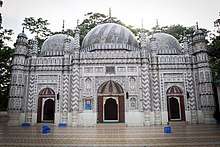
Bazra Shahi Mosque is one of the major archaeological works in undivided Bengal. It is situated eight miles (thirteen kilometres) from district headquarter Maijdee Court. Amir Sanaullah, the owner of Bazra Jaigir started the construction of the Bazra'Shahi Mosque in the pattern of Tajmahal in the Hizri year 1134. The construction was completed in the Hizri year 1154. The Bazra Shahi Mosque is an example of Moghal architecture. In the year 1922, Ali Ahmed, the Jaminder of Bazra, plastered the whole exterior of the mosque with China clay.
Queen Lurther's Catholic Church
This is one of the oldest Catholic churches in the country. It was established in 1959, and named after the Queen Lurther at Sonapur of Noakhali Sadar upazila. Its quiet, bland shadowed environment made the Church glamorous. A Christian cemetery containing numerous crosses, a giant statue of Jesus Christ, a flower garden, spectacular ponds,a mission school, a charitable health center, and a crafts center are also seen beside the Church. Around the Church there is a large Christian colony.
Christians in this district had Portuguese ancestry. The Portuguese pirates of Sandwip terrorised the coasts of Noakhali throughout the seventeenth century.[26] Later on they inter-married with the women of the region. In 1844 the first Christian missionary arrived in Noakhali.
The mission maintains two boys' schools and one girls' school at Noakhali and one girls' school at Ewazbalia. It makes few converts.[6]
Gandhi Ashram
The establishment of Gandhi Ashram trust is rooted with the Peace Mission of Mahatma Gandhi immediately after the communal riots in 1946 at Noakhali. Gandhi stayed for about four months in the riot-stricken areas. He started moving around the villages and motivated the people towards his peaceful coexistence and non-violence philosophy. When Gandhiji came to Jayag on 29 January 1947 all sections of the local community extended him whole-hearten support. At that time, Barrister Hemanta Kumar Ghosh of the village donated all his resources to Mahatma for the development and peace of the area and Ambika Kaliganga Charitable Trust was formed. The office of the Gandhi Peace Mission, formerly known as Gandhi Camp, was shifted to the present campus of Jayag, Sonaimuri.
Rajganj Mia Bari
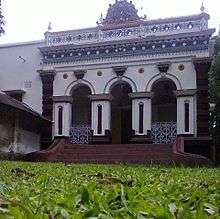
This jomidar bari is known as Rajganj Mia Bari.[27] It is located at Rajgonj union which is four kilometres (two point five miles) west of Maijdee Bazar. Sayed Sultan Alam Chowdhury built this house in 1907.
A book titled Noakhalir Itihas was written by Sri Perimohan Sen, and mentioned the name of Syed Sultan Alam Chowdhury as a prestigious person of Noakhali. His ancestors came here from Baghdad on 5th Magh 1149 Bengali year. The first family member of this house named Syed Sher Alam Baghdadi. He came here only to preach Islam.
Musapur Closure
It is located on the bank of the Feni river,in Companygonj upazila. The Musapur Closure Dam, which was constructed at a cost of Tk 194 crore at Musapur under Companiganj Upazila of the district, has ushered in a new prospect to the people living around it. The dam was constructed applying workforce of around 6,000 labourers and is supposed to prevent salinity to about 1.30 lakh hectares of cropland under 14 upazilas in Noakhali, Comilla and Chandpur districts. However, a certain portion of the dam was washed away within three hours of its construction; later with the joint efforts of locals and the Water Development Board (WDB) here, the erosion could be prevented.
Notable residents
- Moudud Ahmed, former prime minister of Bangladesh, was member of 8th Parliament for the Noakhali-5 constituency.
- Moeen U Ahmed, was the thirteenth chief of army staff of the Bangladesh Army from 15 June 2005 to 15 June 2009. He was born in Alipur village, Begumganj, Noakhali.
- Muzaffar Ahmed, popularly known as "Kakababu", one of the founders of the Communist Party of India, was educated at Noakhali Zilla School.
- Kamrul Ahsan, Currently serving as Bangladesh Ambassador to Russia, Secretary to the Government and former Bangladesh High Commissioner to Canada and Singapore.
- Harunur Rashid,Chairman of "Globe Group of Companies"
- Mohammad Ruhul Amin, Bangladesh Navy engine room artificer posthumously awarded the nation's highest bravery award for service during the Bangladesh Liberation War
- Jharna Dhara Chowdhury, social activist and Secretary of the Gandhi Ashram Trust in Noakhali. Awarded the Ekushey Padak for social service (2015) and Padma Shri award (2013).
- Kabir Chowdhury, was an academic, essayist, materialist, translator, cultural worker, civil society activist in Bangladesh.
- Motaher Hussain Chowdhury, a Bengali writer, was born in Noakhali. Special work: Songskriti Kotha.
- Mufazzal Haider Chaudhury, educator and a martyr of the Bangladesh War of Independence, was born in Khalishpur village in what is now Begumganj Upazila.
- Munier Choudhury, Bangladeshi educator, playwright, literary critic and political dissident. He was a victim of the mass killing of Bengali intellectuals in 1971
- Shirin Sharmin Chaudhury-Current & First lady speaker of the Bangladesh parliament.
- Zahurul Haq, a sergeant in the Pakistan Air Force, whose arrest in the Agartala Conspiracy Case and 1969 death in custody led to mass protests, graduated from Noakhali Zilla School.[28]
- MA Hashem, is the founder and chairman of Partex Group.
- Belal Shafiul Huq, was a four-star rank army general and the Former (17th) chief of army staff of the Bangladesh Army, in office since 25 June 2015 to 2019.
- Annisul Huq, was an entrepreneur, TV show host and the former mayor of Dhaka North City Corporation. He was born in Kabirhat, Noakhali.
- Tabarak Husain, career foreign service officer, former foreign secretary of Bangladesh and former Bangladesh ambassador to United States.
- Muhammad Ishaq, Bangladeshi historian.
- Abul Kashem,Chairman of "Abul Khair Group".
- Serajul Alam Khan, is a political theorist and founder of "Sadhin Bangla Nucleus" a secret organisation, which theorised the creation of Bangladesh.
- A. B. M. Musa, awarded the Ekushey Padak for journalism in 1999, attended Noakhali Zilla School.[29]
- Obaidul Quader, Present general secretary of the Bangladesh Awami League and Minister of Road Transport and Bridges Ministry, was born in Bara Rajapur village
- Abdus Salam, (1910-1977) former editor of the Pakistan Observer, later the Bangladesh Observer. Ekushey Padak winning journalist
- Abdus Shakur, was a former Secretary to the Government and a leading litterateur and musicologist.
- Abdul Malek Ukil, a drafter of the Constitution of Bangladesh, member of parliament, Minister of Health, and Minister of Home Affairs, was born in Rajarampur village, Noakhali Sadar Upazila.
References
- "Sub-national HDI - Area Database - Global Data Lab". hdi.globaldatalab.org. Retrieved 18 March 2020.
- Encyclopedia of Britannica
- Lipi, Jahanara Akhter (2012). "Noakhali District". In Islam, Sirajul; Jamal, Ahmed A. (eds.). Banglapedia: National Encyclopedia of Bangladesh (Second ed.). Asiatic Society of Bangladesh.
- "এক নজরে নোয়াখালী". বাংলাদেশ জাতীয় তথ্য বাতায়ন, নোয়াখালী জেলা.
- "Noakhali". lged.gov.bd. Executive Engineer's Office LGED-Noakhali. Retrieved 25 March 2019.
- Webster, J.E (1911). Eastern Bengal and Assam District Gazetteers:Noakhali. Allahbad: The Pioneer Press.
- Batabyal, Rakesh (2005). Communalism in Bengal: From Famine to Noakhali, 1943–47. New Delhi: Sage Publications. p. 282. ISBN 81-7829-471-0.
H.S. Suhrawardy, the chief minister, while answering the question of Dhirendra Nath Dutt on the floor of the Bengal Legislative Assembly, gave a figure of 9,895 cases of forcible conversion in Tippera, while that for Noakhali was not known 'but (which) ran into thousands'.
- Salik, Siddiq, Witness to Surrender, pp126
- "Bangladesh war: The article that changed history – Asia". BBC. 25 March 2010.
- Sharlach 2000, pp. 92–93.
- Sajjad 2012, p. 225.
- White, Matthew, Death Tolls for the Major Wars and Atrocities of the Twentieth Century
- Team, Editorial (17 December 2017). "Why Do India Celebrate 'Vijay Diwas' On 16th December". SSBToSuccess. Retrieved 18 December 2017.
- "About us". Liberation War Museum. Archived from the original on 8 November 2011. Retrieved 21 November 2011.
- Team, Editorial (17 December 2017). "Why Do India Celebrate 'Vijay Diwas' On 16th December". SSBToSuccess. Retrieved 18 December 2017.
- "List of Deputy Commissioners". Ministry of Public Administration. Archived from the original on 14 December 2018. Retrieved 11 April 2019.
- "AL men appointed administrators". The Daily Star. Archived from the original on 1 July 2015. Retrieved 25 March 2019.
- Parliament Members from Noakhali.
- District Statistics 2015,Noakhali (PDF), Bangladesh Bureau of Statistics(BBS), archived from the original (PDF) on 26 October 2014
- District Statistics 2011,Noakhali (PDF), Bangladesh Bureau of Statistics(BBS), archived from the original (PDF) on 26 October 2014
- Webster, J.E.(1911). Noakhali District Gazetteers. Retrieved from https://archive.org/details/dli.bengal.10689.10182/page/n111/mode/2up.
- Hunter, W.W.(1876). A Statistical Account of Bengal Retrieved from https://archive.org/details/in.ernet.dli.2015.39091/page/n349/mode/2up.
- Mujib College
- "Ministry of Health and Family Welfare (MOHFW) HEALTH BULLETIN 2013". app.dghs.gov.bd. Archived from the original on 3 November 2014. Retrieved 25 March 2018.
- Abdul Aouwal, "Nijhum Dwip National Park Bangladesh", Ontaheen, 16 June 2016 2:50 pm
- Danvers, F. C., The Portuguese in India
- Tourist Places in Bangladesh https://www.touristplaces.com.bd/noakhali/rajgonj-mia-bari/
- Rahman, S M Mahfuzur (2012). "Haq, Zahurul". In Islam, Sirajul; Jamal, Ahmed A. (eds.). Banglapedia: National Encyclopedia of Bangladesh (Second ed.). Asiatic Society of Bangladesh.
- "সাংবাদিক এবিএম মূসার সংক্ষিপ্ত জীবনী" [A Brief Biographt ABM Musa]. bdtoday24 (in Bengali). Dhaka. 1 April 2014.
